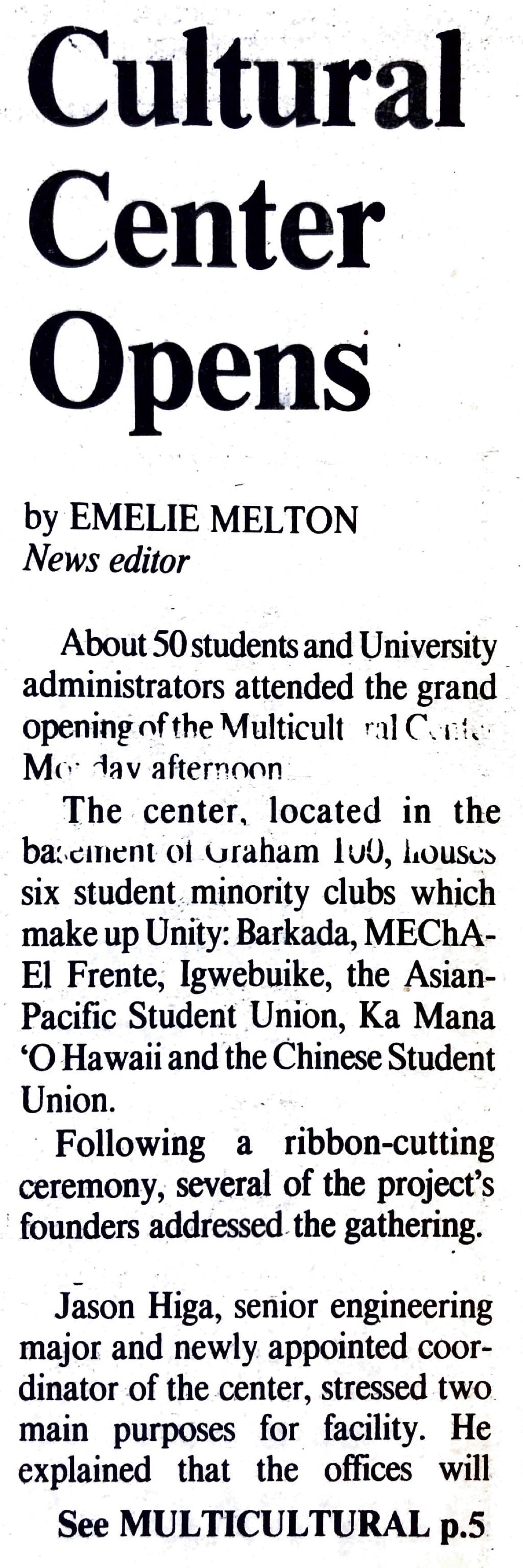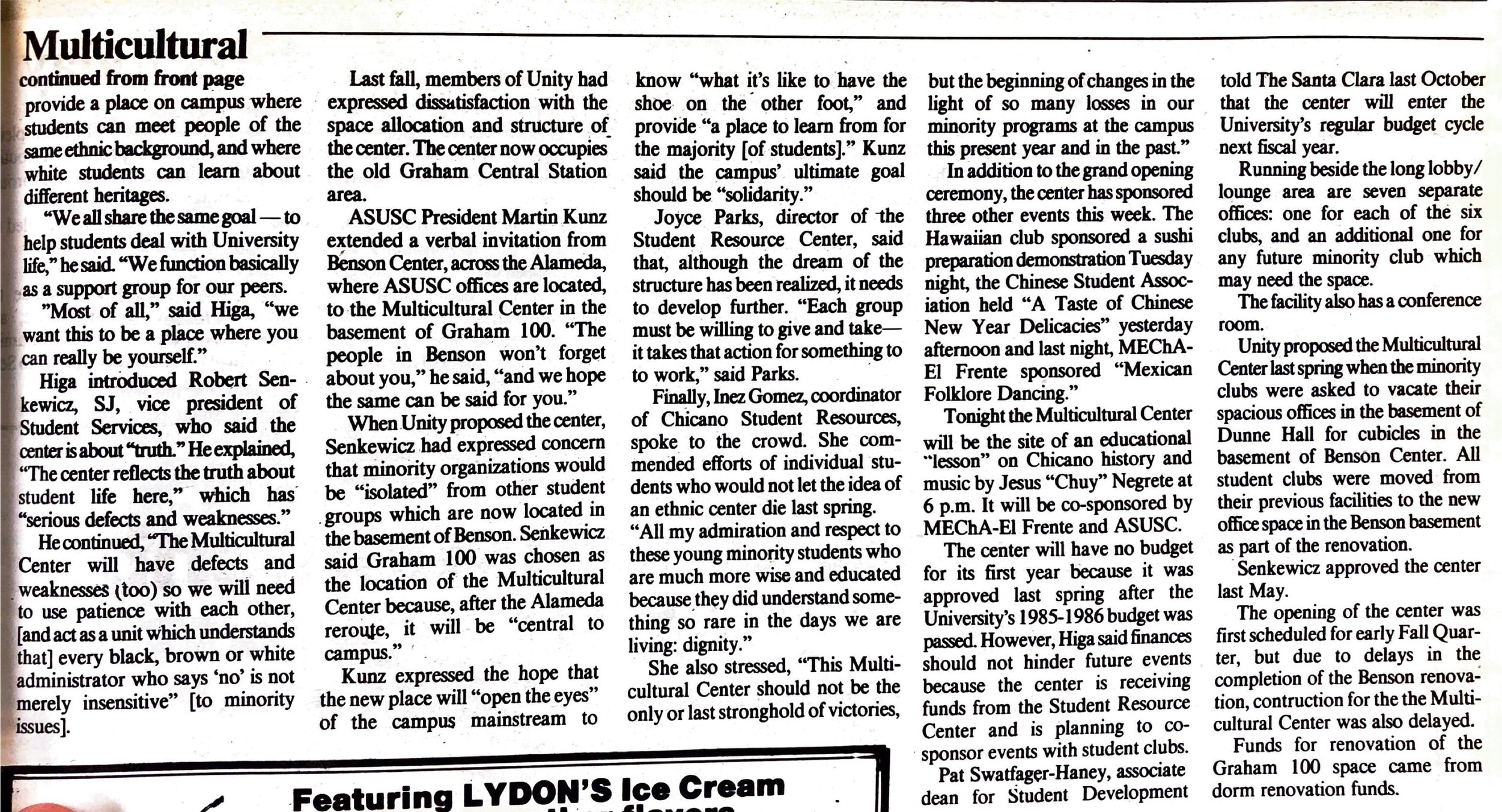Cultural Center Opens
Originally published in The Santa Clara on Feb. 13, 1986, this news story marked the Feb. 10, 1986 opening of Santa Clara’s Multicultural Center (MCC).
By Emelie Melton
Volume 64 No. 14, Feb. 13, 1986
About 50 students and University administrators attended the grand opening of the Multicultural Center Monday afternoon.
The center, located in the basement of Graham 100, houses six student minority clubs which make up Unity: Barkada, MEChA-El Frente, Igwebuike, the Asian-Pacific Student Union, Ka Mana ‘O Hawaii and the Chinese Student Union.
Following a ribbon-cutting ceremony, several of the project's founders addressed the gathering.
Jason Higa, senior engineering major and newly appointed coordinator of the center, stressed two main purposes for [the] facility. He explained that the offices will provide a place on campus where students can meet people of the same ethnic background, and where white students can learn about different heritages.
“We all share the same goal — to help students deal with University life,” he said. “We function basically as a support group for our peers.”
“Most of all,” said Higa, “We want this to be a place where you can really be yourself.”
Higa introduced Robert Senkewicz, SJ, vice president of Student Services, who said the center is about “truth.” He explained, “The center reflects the truth about student life here,” which has “serious defects and weaknesses.”
He continued, “The Multicultural Center will have weaknesses (too) so we will need to use patience with each other, [and act as a unit which understands that] every black, brown or white administrator wgo says ‘no’ is not merely insensitive” [to minority issues].
Last fall, members of Unity had expressed dissatisfaction with the space allocation and structure of the center. The center now occupies the old Graham Central Station area.
ASUSC President Martin Kunz extended a verbal invitation from Benson Center, across the Alameda, where ASUSC offices are located, to the Multicultural Center in the basement of Graham 100. “The people in Benson won’t forget about you,” he said, “and we hope the same can be said for you.”
When Unity proposed the center, Senkewicz had expressed concern that minority organizations would be “isolated” from other student groups which are not located in the basement of Benson. Senkewicz said Graham 100 was chosen as the location of the Multicultural Center because, after the Alameda reroute, it will be “central to campus.”
Kunz expressed the hope that the new place will “open the eyes” of the campus mainstream to know "what it's like to have the shoe on the other foot," and provide "a place to learn from for the majority [of students]." Kunz said the campus' ultimate goal should be "solidarity."
Joyce Parks, director of the Student Resource Center, said that, although the dream of the structure has been realized, it needs to develop further. "Each group must be willing to give and take—it takes that action for something to work," said Parks.
Finally, Inez Gomez, coordinator of Chicano Student Resources, spoke to the crowd. She commended efforts of individual students who would not let the idea of an ethnic center die last spring. "All my admiration and respect to these young minority students who are much more wise and educated because they did understand something so rare in the days we are living: dignity."
She also stressed, "This Multicultural Center should not be the only or last stronghold of victories, but the beginning of changes in the light of so many losses in our minority programs at the campus this present year and in the past."
In addition to the grand opening ceremony, the center has sponsored three other events this week. The Hawaiian club sponsored a sushi preparation demonstration Tuesday night, the Chinese Student Association held "A Taste of Chinese New Year Delicacies" yesterday afternoon and last night, MEChA-El Frente sponsored "Mexican Folklore Dancing."
Tonight the Multicultural Center will be the site of an educational "lesson" on Chicano history and music by Jesus "Chuy" Negrete at 6 p.m. It will be co-sponsored by MEChA-El Frente and ASUSC.
The center will have no budget for its first year because it was approved last spring after the University's 1985-1986 budget was passed. However, Higa said finances should not hinder future events because the center is receiving funds from the Student Resource Center and is planning to co-sponsor events with student clubs.
Pat Swatfager-Haney, associate dean for Student Development told The Santa Clara last October that the center will enter the University's regular budget cycle next fiscal year.
Running beside the long lobby/lounge area are seven separate offices: one for each of the six clubs, and an additional one for any future minority club which may need the space.
The facility also has a conference room.
Unity proposed the Multicultural Center last spring when the minority clubs were asked to vacate their spacious offices in the basement of Dunne Hall for cubicles in the basement of Benson Center. All student clubs were moved from their previous facilities to the new office space in the Benson basement as part of the renovation.
Senkewicz approved the center last May.
The opening of the center was first scheduled for early Fall Quarter, but due to delays in the completion of the Benson renovation, contruction for the Multicultural Center was also delayed.
Funds for renovation of the Graham 100 space came from dorm renovation funds.

